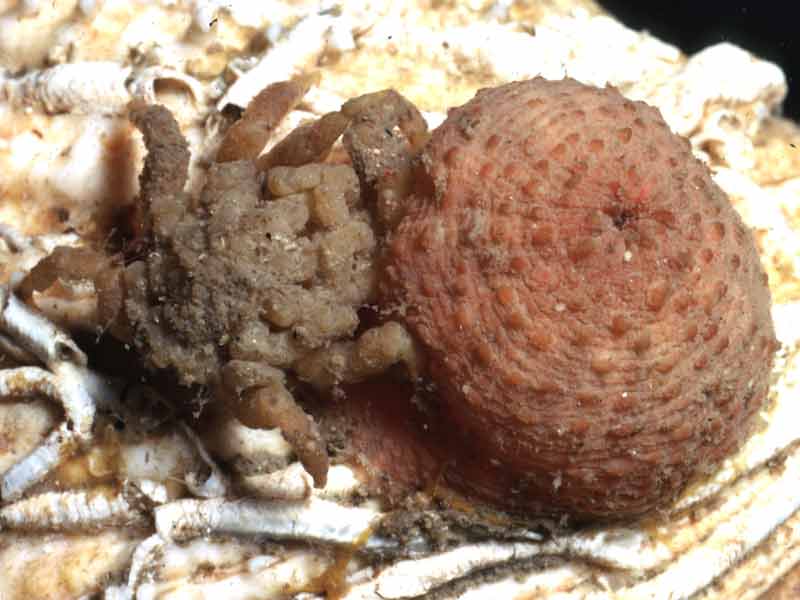A sea spider (Pycnogonum litorale)
Distribution data supplied by the Ocean Biodiversity Information System (OBIS). To interrogate UK data visit the NBN Atlas.Map Help
| Researched by | Jessica Heard | Refereed by | This information is not refereed |
| Authority | (Strøm, 1762) | ||
| Other common names | - | Synonyms | - |
Summary
Description
Recorded distribution in Britain and Ireland
Pycnogonum litorale can be found all around the coasts of Britain and Ireland and, despite its name, has been widely recorded in the sublittoral and offshore. It is the only species of the genus to be found around Britain.Global distribution
Recorded in the North East Atlantic from the Arctic to southern Spain, including the North Sea, the Kattegat, and the Mediterranean, and from the north-east Atlantic coast of North America.Habitat
Pycnogonum litorale is found on the lower shore and sublittoral, underneath flat rocks and on seaweed and feeding on sea anemones.Depth range
Littoral to ca 900 mIdentifying features
- Chelifores and palps absent
- Proboscis tapers abruptly and is never longer than the trunk
- Short curved legs are slightly shorter than the body length
- 9-segemented ovigerous legs arepresent only in males
- No auxiliary claws
Additional information
Breeding generally occurs between spring and autumn and the males and females remain clinging to each other in the mating position for up to 5 weeks. Following mating the male carries the eggs for several weeks (King, 1974).Listed by
- none -
Bibliography
Fish, J.D. & Fish, S., 1996. A student's guide to the seashore. Cambridge: Cambridge University Press.
King, P.E. & Case, R.M., 1986. Sea Spiders (Pycnogonids) in and around Milford Haven (South West Wales). Field Studies, 6, 517-529.
King, P.E., 1974. British Sea Spiders. Arthropoda: Pycnogonida. London: Academic Press. [Synopses of the British Fauna (New Series) No. 5.]
King, P.E., 1986. Sea Spiders. A Revised Key to the Adults of Littoral Pycnogonida in the British Isles. Field Studies, 6, 493-516.
Datasets
Centre for Environmental Data and Recording, 2018. Ulster Museum Marine Surveys of Northern Ireland Coastal Waters. Occurrence dataset https://www.nmni.com/CEDaR/CEDaR-Centre-for-Environmental-Data-and-Recording.aspx accessed via NBNAtlas.org on 2018-09-25.
Environmental Records Information Centre North East, 2018. ERIC NE Combined dataset to 2017. Occurrence dataset: http://www.ericnortheast.org.ukl accessed via NBNAtlas.org on 2018-09-38
Fenwick, 2018. Aphotomarine. Occurrence dataset http://www.aphotomarine.com/index.html Accessed via NBNAtlas.org on 2018-10-01
Kent Wildlife Trust, 2018. Kent Wildlife Trust Shoresearch Intertidal Survey 2004 onwards. Occurrence dataset: https://www.kentwildlifetrust.org.uk/ accessed via NBNAtlas.org on 2018-10-01.
NBN (National Biodiversity Network) Atlas. Available from: https://www.nbnatlas.org.
OBIS (Ocean Biodiversity Information System), 2025. Global map of species distribution using gridded data. Available from: Ocean Biogeographic Information System. www.iobis.org. Accessed: 2025-08-08
Citation
This review can be cited as:
Last Updated: 14/02/2005



